Quick Facts:
- BC Provincial Parks website: https://bcparks.ca/ruckle-park/
- Access to water: camp sites are on rocky outcrops unsuitable for launching a water craft. A day use area with a pebble beach is nearby for launching hand-carried water crafts.
- Pit toilet, drinking water source, garbage collection
- Activities: beach combing, hiking, visiting the heritage Ruckle Farm
- Beach type: rocky tidal pools
- Outdoor Fam rating: 10 out of 10
I have done two awesome paddle camping trips this summer, once in Indian Arm, and another time in Sechelt Inlet. Both were fantastic trips, but I wished I could share the awesome experience of rustic marine camping with my family. It’s truly a whole different experience camping with the ocean as our front yard, and the stars as our blanket.
When I came across the campground at Ruckle Provincial Park, I knew this is where we needed to go. It is a walk-in, first-come-first-served campground where you could pitch your tents on the shores of Salt Spring Island. It’s basically a paddle camping experience (with more people and more convenience) without having to paddle there.

The photos may look like it’s a free-for-all, camp-anywhere type mayhem, but it’s not. The picnic tables are numbered and represent a campsite for a camping party (up to 4 adults and 4 children).


The campground has pit toilets, garbage bins, and cold water taps. No showers. There are 8 RV sites way back in the parking area, so RV campers would not enjoy the awe-inspiring ocean front camping experience.
We knew this would be extremely coveted even during the week, and with two little guys in tow, it would be hard for us to beat the early birds who flock to the park on the first ferry leaving Swartz Bay at 7am. So we devised a plan to stay at a hotel in Ganges for a night, and the grandparents headed to the campground to scout for a spot the following morning. We figured that most campers would stay about 3 nights on average and there were 78 campsites (68 FCFS and 10 reserved), there should be more than 20 sites on average that turn over every day.
Even with that, they almost couldn’t find a single spot. They walked the campground from end to end, asking anyone who looked like they were packing things up. They either weren’t leaving that day, or someone else already claimed their spot.
My parents learned that there was a hierarchy of desirability of these campsites. The most desirable ones (let’s call them “Tier 1”) are right on the shore, with 180 degrees of unobstructed ocean views. The second row (Tier 2) would have other people’s tents and gears in parts of their views but it’s still fantastic. The sites behind the walking path, some of which are located in the woods, are further from the shore and their views are considerably broken up by the first two rows and sparse trees (Tier 3). Then there were the overflow sites that are basically a patch of grass where people who really couldn’t find a proper spot could beg the camp host to stay the night (Tier 4).


Every morning, many of the Tier 3 and 4 campers would migrate down and find out which people in the Tier 1 and 2 are leaving for the day. They would claim these Tier 1 and 2 spots before the new comers even have a chance to get off the ferry.
Before 9 or 10 am, the campsites on the shore would all be spoken for. By 11am, most of the Tier 3 sites would also be taken by the new comers. If you came after 11am and couldn’t find a spot, the camp host may ask you to find accommodation elsewhere on the island (very difficult since most of the hotels would be full). If you cycled to Ruckle, you would usually be allowed to camp at the overflow area because it would be cruel to ask you to cycle around the island for accommodation. Then the cycle of migrating campers would repeat the next morning.
My parents were too polite to bug people eating breakfast, but they were getting desperate after they walked through the whole campground back and forth multiple times. Thankfully, they finally spotted a family who weren’t leaving yet, but found a different open spot that they wanted to move to. So as they moved out, we moved in. We won the great Ruckle Musical Chairs!

The next task was to move our gears from the parking lot. It’s a 5 minute walk down a gravel path with a few small roots. It really helps if you have a cart, because although there were a few wheelbarrows available, they all but disappear every morning during the move in/out time.


One unique and very important feature of this campground: there are no predators on the island so we didn’t have to worry about bear-proofing our campsite. This means we didn’t have to bring the cooler and stove back and forth to the car every time we leave. The camp host asked us to just make sure there wasn’t food out in the open because there may be crows, pets, and “a stupid deer sometimes walks through and knock things over”.
We quickly set up camp. The afternoon sun was very hot, and one major downside of on-shore camping was the lack of tree cover.


Grandpa spent some quality time on our front yard:

Junior played on the shore:

I went for a walk further down the campground. I came across several small garter snakes in the more grassy/wooded area, so that’s something to keep in mind if you are afraid of snakes. They are harmless but slithering critters are not everyone’s favorite.


Unable to withstand the midday summer sun, we escaped to Burgoyne Bay for a paddle, supposedly one of the best places for crabbing on Salt Spring Island. For a paddleboard, it’s best to park here and launch from the dock.

For our parents’ inflatable raft, they had to temporarily park at a private driveway and use a “closed” boat ramp. Locals told us it’s ok to use this to launch a small watercraft.

We went for a very leisurely paddle, basically just crossed the bay and stayed under some shades. The grandparents brought their crab trap to try their luck.







The very first trap was a resounding success! We got 3 legal-sized red rock crabs using left over chicken bones from lunch. Another trap with fresh chicken legs actually came up empty. There was a seal that looked very suspect and would dive towards our traps every time we dropped them. My dad suspected he was either chewing on the chicken legs or playing with our trap.

It’s too bad that the shores at our campground were too rocky to launch a paddleboard safely, otherwise we could have tried crabbing right off our campsite too. (Our traps were the double-ring ones that need to be pulled up vertically. It wouldn’t work very well if thrown from shore.)
On a second trip, we found a flat area on the beach near campsites 28 and 29, and successfully launched my paddleboard and crabbed!

With the added fresh crabs, we had the most delicious meal with the most spectacular backdrop ever on a camping trip.





After dinner, the sun started to set. Tina snapped this surreal photo of my parents enjoying a moment of serenity.

And the near-full moon rose.


Later in the evening, the ferries lit up and put on a quiet light show.

We stayed up later than usual to enjoy the ocean views at night. Grandma had a towel wipe down using water we heat up on our stove in a new stand-up tent they got. Lack of shower facilities combined with sweaty days of beach fun may be problematic for some.

The following morning was cloudy and cool, and there was rain in the forecast. We debated for some time, not wanting to leave the million-dollar campsite after just one night.
But when the fog moved in and covered the ocean view, and the kids started shivering during breakfast, we knew we should get going.

Before we packed up, I went to explore some tidal pools with Junior.




Kids from a neighboring family brought some animals to show us too:




I wanted to recreate the serene and peaceful photo of the grandparents at the bench for Tina and the boys. It was not meant to be.

Oh, and Ruckle has a working farm but we were too busy at the beach and only stopped on our way out. We did buy some lamb from the local butcher though.

Ruckle Park also has a day-use area, which is a fair distance away from the campground. Down a narrow trail, there’s a nice calm bay where a paddleboard could be launched. To lug a paddleboard here from the campground would take real commitment though.




We would have loved to stay at least 2 nights at Ruckle had the weather been nicer. Probably 3-4 nights would be even better so that we can see more of Salt Spring Island. (We did come back for a 3-night group camping trip to Ruckle in 2024, but still, we mostly stayed at this incredible park again.)
We took a big gamble and got very lucky with our campsite this time. Next time we visit, I would try to get here on the first ferry and start politely asking anyone who’s awake whether they are leaving. Alternatively, there are ten Tier 3 tent pads available for reservation. I would reserve one night and join the morning musical chairs the next day.
It’s that awesome.
Discover more from Outdoor Family
Subscribe to get the latest posts sent to your email.

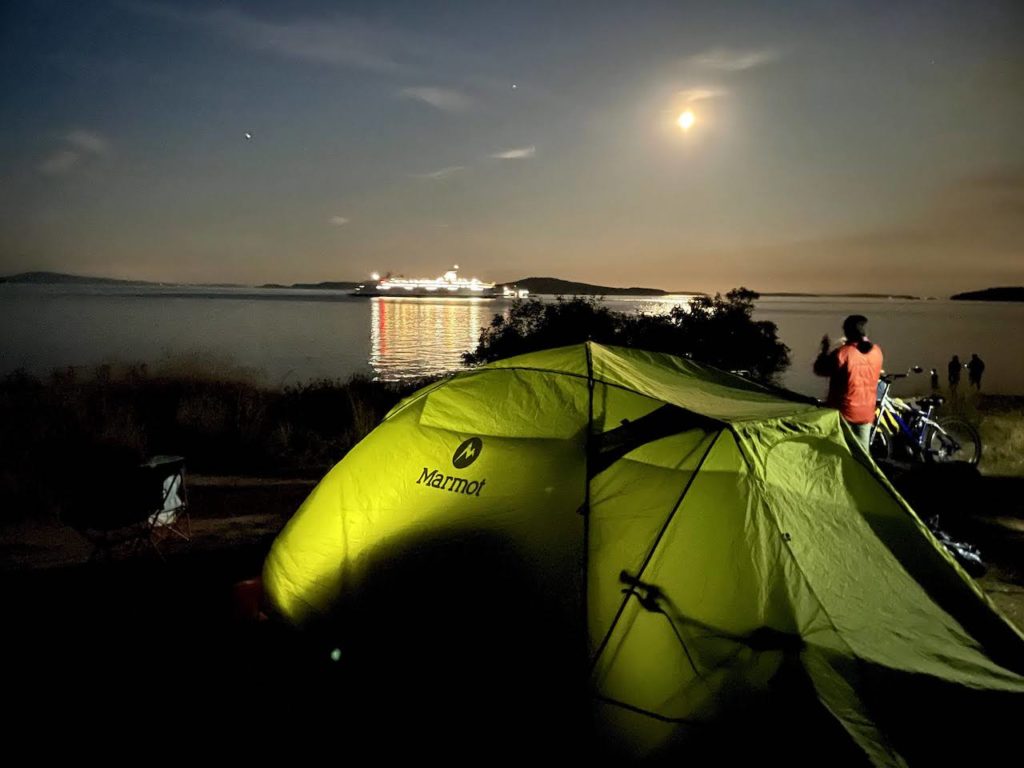
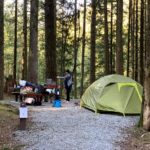
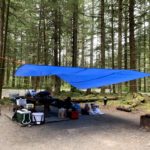
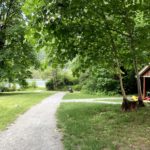
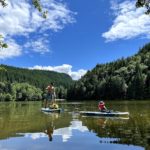
Pingback: 2021 Island Camping Trip – Outdoor Family
Oh man this brings back some great childhood memories. Ruckle Park on Salt Spring was our summer family camping trip spot. Thanks for sharing this!
Nice! Did you manage to paddle in Ruckle? I’m thinking the day use area beach is the only access, but if you have a secret path closer to the campground, let me know XD
Pingback: Camping at Cal Cheak Recreation Site – Outdoor Family
Pingback: Camping at Porteau Cove Provincial Park - Outdoor Family
Pingback: Camping at Juan de Fuca Provincial Park – China Beach Campground - Outdoor Family